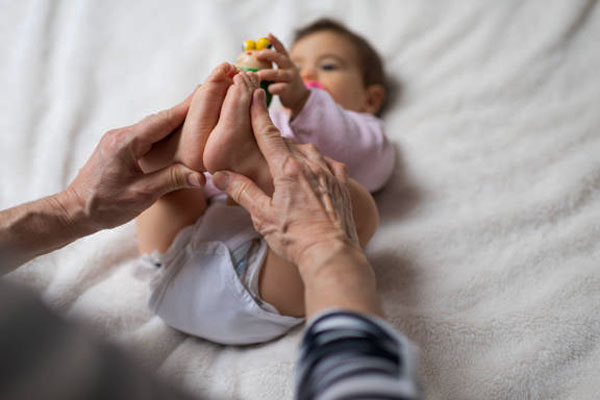Developmental Hip Dysplasia
Developmental dysplasia of the hip (DDH) occurs when babies are born with hip joints that are not properly formed. It is also called congenital hip dislocation (CHD). The normal hip has a ball-and-socket joint. The ball at the upper end of the femur fixes firmly in the socket of the large pelvic bone. Children who have this condition have the ball loosely placed in the socket, which can be easily dislocated.

What are the causes and risk factors of Developmental Hip Dysplasia?
Although there are no known causes for the occurrence of this condition, there are certain contributing factors.
These are as given below:
- Low levels of amniotic fluid in the womb
- Breech presentation
- Family history
- Other congenital anamolies
Confinement in the uterus may cause this condition, and it is more likely to be seen in the first pregnancy. Congenital hip dislocation is more commonly seen in girls than in boys. It can take place anytime during the first year of a child's development.
What are the symptoms associated with Developmental Hip Dysplasia?
If your child suffers from this condition, he or she may exhibit the following:
- Legs appear to turn outward or there may be a difference in their length.
- Appearance of folds on buttocks which are uneven on extending the legs.
- Limited range of motion.
- Delay in the child's motor development, affecting the way the baby walks, crawls, and sits.
How is Developmental Hip Dysplasia diagnosed?
The doctor screens the child for this condition at the time of birth, and this continues till the first year of the child's life.
-
Physical examination: The doctor gently maneuvers the child's hips and legs while listening for "clicking" or "clunking" sounds, which indicate dislocation. The physical examination includes two tests:
- Ortolani Test: In this test, the doctor applies upward force as he moves the child's hip away from the body. This movement away from the body is termed abduction.
- Barlow Test: During this test, the doctor applies downward force while he moves the child's hip across the body. This movement towards the body is called adduction.
Both of these tests are accurate until the child is 3 months old. In older children, this condition is indicated by limited abduction, limping, and differences in leg lengths if the child has a single affected hip.
- Imaging Techniques: Developmental hip dysplasia can be diagnosed by imaging techniques like CT and MRI scans. These provide cross-sectional imaging of the condition. An MRI gives a clear image to assess the hip joint. In babies who are less than 6 months old, an ultrasound usually helps diagnose this condition.
What are the treatment options?
Use of Pavlik harness (a specially designed brace to position the child's hip): If your baby is less than 6 months old, a Pavlik harness is used to rectify the condition. The purpose of this harness is to press the hip joints into the socket. The harness works in such a way that it abducts the hips by securing the child's legs in a frog-like position. The Pavlik harness must be worn full-time or part-time, depending on the child’s age and severity of the condition. This treatment must be followed for 6 to 12 weeks.
Surgery: If the child does not show improvement with a Pavlik harness or is too big to use the harness, surgical methods are opted for. Surgery is performed under general anesthesia. It is of the following types:
- Closed reduction: In this, the doctor maneuvers the baby's hips into the socket.
- Open reduction: This surgery is done to put the hips back in position after removing the obstacles.
After surgery, the baby's hips and legs are put in a cast for up to 12 weeks. If the child is 18 months of age or older, femoral or pelvic osteotomies may be done. This procedure requires the doctor to reshape the upper end of the femur (thigh bone) or the acetabulum of the pelvis (hip socket).
Long-term outlook
It is not possible to prevent developmental hip dysplasia in your child. The doctor should check the newborn child for signs of developing this condition soon after delivery. An invasive treatment may not be needed if this condition is identified early and treated with the Pavlik harness. Some cases may require more than one surgery and years of follow-up to ensure an optimal outcome and that the hips develop normally.